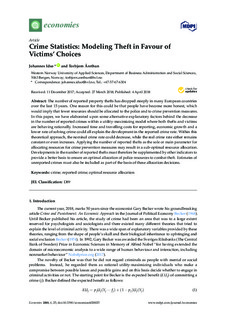| dc.contributor.author | Idsø, Johannes | |
| dc.contributor.author | Årethun, Torbjørn | |
| dc.date.accessioned | 2019-01-18T11:17:00Z | |
| dc.date.available | 2019-01-18T11:17:00Z | |
| dc.date.created | 2018-04-05T14:31:21Z | |
| dc.date.issued | 2018 | |
| dc.identifier.citation | Idsø, J., & Årethun, T. (2018). Crime statistics: Modeling theft in favour of victims’ choices. Economies, 6(25), 1-14. | nb_NO |
| dc.identifier.issn | 2227-7099 | |
| dc.identifier.uri | http://hdl.handle.net/11250/2581277 | |
| dc.description.abstract | The number of reported property thefts has dropped steeply in many European countries over the last 15 years. One reason for this could be that people have become more honest, which would imply that fewer resources should be allocated to the police and to crime prevention measures. In this paper, we have elaborated upon some alternative explanatory factors behind the decrease in the number of reported crimes within a utility-maximizing model where both thefts and victims are behaving rationally. Increased time and travelling costs for reporting, economic growth and a lower rate of solving crime could all explain the development in the reported crime rate. Within this theoretical approach, the nominal crime rate could decrease, while the real crime rate either remains constant or even increases. Applying the number of reported thefts as the sole or main parameter for allocating resources for crime prevention measures may result in a sub-optimal resource allocation. Developments in the number of reported thefts must therefore be supplemented by other indicators to provide a better basis to ensure an optimal allocation of police resources to combat theft. Estimates of unreported crimes must also be included as part of the basis of these allocation decisions | nb_NO |
| dc.language.iso | eng | nb_NO |
| dc.rights | Navngivelse 4.0 Internasjonal | * |
| dc.rights.uri | http://creativecommons.org/licenses/by/4.0/deed.no | * |
| dc.subject | crime | nb_NO |
| dc.subject | optimal resource allocation | nb_NO |
| dc.title | Crime Statistics: Modeling Theft in Favour of Victims’ Choices. | nb_NO |
| dc.type | Journal article | nb_NO |
| dc.type | Peer reviewed | |
| dc.description.version | publishedVersion | nb_NO |
| dc.rights.holder | © 2018 by the authors. | nb_NO |
| dc.subject.nsi | VDP::Samfunnsvitenskap: 200::Økonomi: 210 | nb_NO |
| dc.source.pagenumber | 14 | nb_NO |
| dc.source.volume | 6 | nb_NO |
| dc.source.journal | Economies | nb_NO |
| dc.source.issue | 25 | nb_NO |
| dc.identifier.doi | 10.3390/economies6020025 | |
| dc.identifier.cristin | 1577753 | |
| cristin.unitcode | 203,5,3,0 | |
| cristin.unitname | Avdeling for samfunnsfag - Sogn og Fjordane | |
| cristin.ispublished | true | |
| cristin.fulltext | original | |

